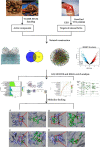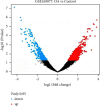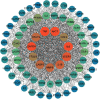Potential Therapeutic Mechanism of Radix Angelicae Biseratae and Dipsaci Radix Herb Pair against Osteoarthritis: Based on Network Pharmacology and Molecular Docking
- PMID: 37089716
- PMCID: PMC10121345
- DOI: 10.1155/2023/2140327
Potential Therapeutic Mechanism of Radix Angelicae Biseratae and Dipsaci Radix Herb Pair against Osteoarthritis: Based on Network Pharmacology and Molecular Docking
Abstract
Background: A major contributor to older disability is osteoarthritis. Radix Angelicae Biseratae (known as Duhuo in China, DH, the dried rhizome of Angelica pubescens) and Dipsaci Radix (known as Xuduan in China, XD, the dried rhizome of Dipsacus asper Wall) herb pair (DXHP) is widely used to treat osteoarthritis, but the underlying molecular mechanisms still have not been revealed. This research aimed to illustrate the therapeutic mechanism of DXHP against osteoarthritis through the techniques of network pharmacology and molecular docking.
Methods: Gene targets for osteoarthritis and active ingredients for DXHP were screened based on the pharmacology public database and the gene-disease target database. The software program Cytoscape was used to visualize the active chemical target-disease gene network. The STRING biological information website was used to investigate protein interactions. On the Metascape bioinformatics website, Gene Ontology (GO) and Kyoto Encyclopedia of Genes and Genomes (KEGG) pathway enrichment were carried out. The molecular docking of the important chemicals and primary targets identified by the aforementioned screening was performed using Autodock software.
Results: Twenty-six active substances from the DXHP that had strong connections to 138 osteoarthritis-related targets were screened out. According to network analysis, TNF, GAPDH, IL-6, AKT-1, IL-1B, and VEGFA are prospective therapeutic targets, while osthole, cauloside A, ammidin, angelicone, beta-sitosterol, and asperosaponin VI may be significant active components. 1705 biological processes (BP), 155 molecular functions (MF), and 89 cellular components (CC) were identified by GO analysis. KEGG analysis indicated that IL-17, NF-kappa B, HIF-1, MAPK, and AGE-RAGE signaling pathways are potentially involved. Molecular docking showed that cauloside A, osthole, and β-sitosterol have excellent binding activity with main targets.
Conclusions: This study comprehensively illuminated the active ingredients, potential targets, primary pharmacological effects, and relevant mechanisms of the DXHP in the treatment of OA. These findings provide fresh thoughts into the therapeutic mechanisms of the main active ingredients of DXHP and provide a reference for further exploration and clinical applications of DXHP.
Copyright © 2023 Yujiang Xi et al.
Conflict of interest statement
The authors declare that they have no conflicts of interest.
Figures












Similar articles
-
Anti-inflammatory activity of Radix Angelicae biseratae in the treatment of osteoarthritis determined by systematic pharmacology and in vitro experiments.Exp Ther Med. 2021 Jan;21(1):5. doi: 10.3892/etm.2020.9437. Epub 2020 Nov 2. Exp Ther Med. 2021. PMID: 33235614 Free PMC article.
-
Molecular Targets and Mechanisms of Scutellariae radix-Coptidis rhizoma Drug Pair for the Treatment of Ulcerative Colitis Based on Network Pharmacology and Molecular Docking.Evid Based Complement Alternat Med. 2021 Jun 4;2021:9929093. doi: 10.1155/2021/9929093. eCollection 2021. Evid Based Complement Alternat Med. 2021. PMID: 34149863 Free PMC article.
-
Computation and molecular pharmacology to trace the anti-rheumatoid activity of Angelicae Pubescentis Radix.BMC Complement Med Ther. 2022 Nov 26;22(1):312. doi: 10.1186/s12906-022-03769-w. BMC Complement Med Ther. 2022. PMID: 36435778 Free PMC article.
-
Analyzing network pharmacology and molecular docking to clarify Duhuo Jisheng decoction potential mechanism of osteoarthritis mitigation.Medicine (Baltimore). 2022 Dec 16;101(50):e32132. doi: 10.1097/MD.0000000000032132. Medicine (Baltimore). 2022. PMID: 36550856 Free PMC article.
-
[Mechanism of Danggui Sini Decoction in treatment of primary dysmenorrhea based on network pharmacology and molecular docking].Zhongguo Zhong Yao Za Zhi. 2021 Feb;46(4):855-864. doi: 10.19540/j.cnki.cjcmm.20201104.401. Zhongguo Zhong Yao Za Zhi. 2021. PMID: 33645090 Chinese.
References
LinkOut - more resources
Full Text Sources
Research Materials
Miscellaneous

